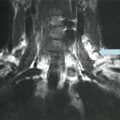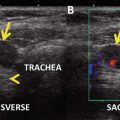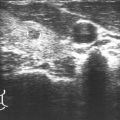Fig. 13.1
Trend of serial basal Tg determination during the first 5 years after thyroidectomy. The graph line displays the Tg levels obtained with a highly sensitive immunometric assay (functional sensitivity, 0.2 ng/mL) at each annual visit. The corresponding TSH values are reported in the graph
Clinical Pearls
Neck ultrasound is the mainstay of follow-up for PTC patients who have not undergone post-thyroidectomy RRA, especially during the first 5 years when serum Tg levels may be relatively uninformative.
In over half of all PTC patients who have not undergone RRA, benign Tg production is already undetectable (i.e., <0.2 ng/mL) at the 1-year follow-up visit, and the percentage approaches 80 % by year 5. For this subset of patients, the specificity of a positive serum Tg assay for predicting persistent/recurrent disease is the same as it is in ablated patients.
Roughly one out of five nonablated patients will have persistent, stable low-level production (≥0.2 ng/mL). In the absence of clinical or imaging evidence of disease, watchful waiting may be the most appropriate course in these cases.
References
1.
Edge SB, Byrd DR, Carducci MA, Compton CC, editors. AJCC cancer staging manual. 7th ed. New York: Springer; 2009.
2.
Cooper DS, Doherty GM, Haugen BR, Kloos RT, Lee SL, Mandel SJ, Mazzaferri EL, McIver B, Pacini F, Schlumberger M, Sherman SI, Steward DL, Tuttle RM, American Thyroid Association (ATA) Guidelines Taskforce on Thyroid Nodules and Differentiated Thyroid Cancer. Revised American Thyroid Association management guidelines for patients with thyroid nodules and differentiated thyroid cancer. Thyroid. 2009;19(11):1167–214.CrossRefPubMed
3.
4.
Schlumberger M, Hitzel A, Toubert ME, Corone C, Troalen F, Schlageter MH, Claustrat F, Koscielny S, Taieb D, Toubeau M, Bonichon F, Borson-Chazot F, Leenhardt L, Schvartz C, Dejax C, Brenot-Rossi I, Torlontano M, Tenenbaum F, Bardet S, Bussière F, Girard JJ, Morel O, Schneegans O, Schlienger JL, Prost A, So D, Archambeaud F, Ricard M, Benhamou E. Comparison of seven serum thyroglobulin assays in the follow-up of papillary and follicular thyroid cancer patients. J Clin Endocrinol Metab. 2007;92(7):2487–95.CrossRefPubMed
5.
Durante C, Montesano T, Attard M, Torlontano M, Monzani F, Costante G, Meringolo D, Ferdeghini M, Tumino S, Lamartina L, Paciaroni A, Massa M, Giacomelli L, Ronga G, Filetti S, PTC Study Group. Long-term surveillance of papillary thyroid cancer patients who do not undergo postoperative radioiodine remnant ablation: is there a role for serum thyroglobulin measurement? J Clin Endocrinol Metab. 2012;97(8):2748–53.CrossRefPubMed
Stay updated, free articles. Join our Telegram channel

Full access? Get Clinical Tree






